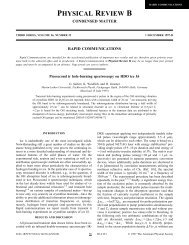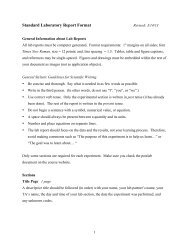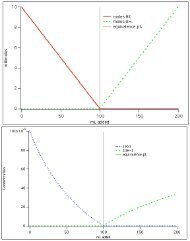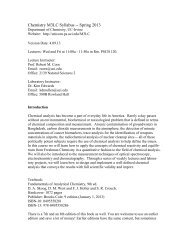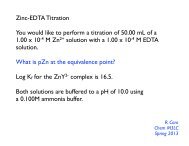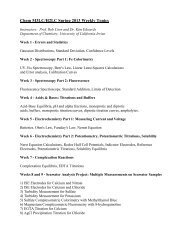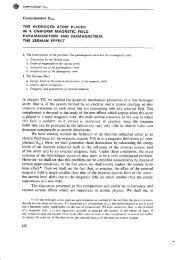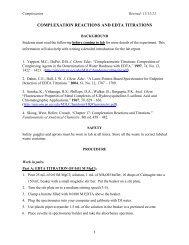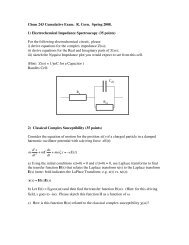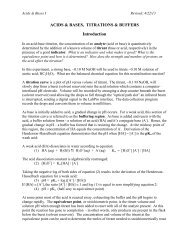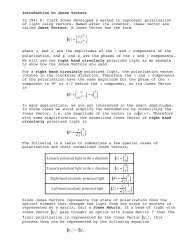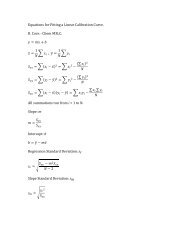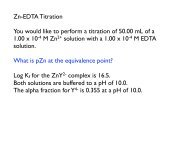Two-dimensional spectroscopy. Application to nuclear magnetic ...
Two-dimensional spectroscopy. Application to nuclear magnetic ...
Two-dimensional spectroscopy. Application to nuclear magnetic ...
Create successful ePaper yourself
Turn your PDF publications into a flip-book with our unique Google optimized e-Paper software.
<strong>Two</strong>-<strong>dimensional</strong> <strong>spectroscopy</strong>. <strong>Application</strong> <strong>to</strong> <strong>nuclear</strong> <strong>magnetic</strong><br />
resonance<br />
W. P. Aue, E. Bartholdi, and R. R. Ernst<br />
Labora<strong>to</strong>rium fiir physikalische Chemie, Eidgeniissische Technische Hochschule, 8006 Ziirich, Switzerland<br />
(Received 13 November 1975)<br />
The possibilities for the extension of <strong>spectroscopy</strong> <strong>to</strong> two dimensions are discussed. <strong>Application</strong>s <strong>to</strong> <strong>nuclear</strong><br />
<strong>magnetic</strong> resonance are described. The basic theory of two-<strong>dimensional</strong> <strong>spectroscopy</strong> is developed.<br />
Numerous possible applications are mentioned and some of them treated in detail, including the elucidation<br />
of energy level diagrams, the observation of multiple quantum transitions, and the recording of highresolution<br />
spectra in inhomogenous <strong>magnetic</strong> fields. Experimental results are presented for some simple<br />
spin systems.<br />
I. INTRODUCTION<br />
Spectroscopy in its classical form has been developed<br />
<strong>to</strong> investigate and <strong>to</strong> identify molecular systems in their<br />
linear approximation. Linearity is a crucial condition<br />
for the spectrum <strong>to</strong> uniquely represent the input/output<br />
relations of a physical system. It is particularly well<br />
fulfilled in optical <strong>spectroscopy</strong> as long as the use of<br />
lasers is disregarded. For linear systems, the entire<br />
apparatus of electronic sY!'tem theory1 can be employed<br />
<strong>to</strong> describe the methods of <strong>spectroscopy</strong>. Of particular<br />
importance is the equivalence of the notions "spectrum"<br />
and "transfer function" or "frequency response function,<br />
" on one hand, and of "interferogram" or "free induction<br />
decay" and "impulse response," on the other.<br />
These correspondences proved <strong>to</strong> be fruitful in connection<br />
with the introduction of Fourier <strong>spectroscopy</strong> in<br />
optical <strong>spectroscopy</strong>2 and in <strong>magnetic</strong> resonance. 3,4<br />
It is well known that linearity is merely an abstract<br />
concept <strong>to</strong> simplify the mathematical treatment. It<br />
does not correspond <strong>to</strong> physical reality, although it may<br />
be an excellent approximation, in many cases.<br />
In radio frequency <strong>spectroscopy</strong>, linearity is restricted<br />
<strong>to</strong> very weak perturbations of the investigated<br />
system, and nonlinear effects are well known <strong>to</strong> occur<br />
in almost any spectroscopic radio frequency experiment.<br />
Typical effects are saturation effects, line<br />
broadening, and line shifts caused by strong perturbations.<br />
5<br />
Some properties of molecular systems can only be<br />
noticed through nonlinear effects, e. g., spin-lattice<br />
relaxation and the connectivity of the various transitions<br />
in the energy level scheme. Spectroscopy has,<br />
therefore, been extended <strong>to</strong> include methods suitable<br />
for the investigation of nonlinear properties of molecular<br />
systems.<br />
A straightforward extension of <strong>spectroscopy</strong> is the<br />
measurement of saturation curves and the analysis of<br />
line shapes under the influence of strong rf fields, although,<br />
in most cases, the information cannot be obtained<br />
directly but must be extracted by means of<br />
iterative approximation procedures. 6<br />
The most fruitful class of techniques was certainly<br />
provided by double resonance. 7 ,8 Here, a strong perturbation<br />
serves <strong>to</strong> modify the system in a nonlinear<br />
fashion. The actual spectroscopic experiment, using<br />
a second, weak perturbation, can again be considered<br />
as the investigation of a linear system. Of particular<br />
importance for the elucidation of the <strong>to</strong>pology of energy<br />
level schemes and indirectly of molecular structure are<br />
techniques like spin tickling, 9 INOOR, 10 and selective<br />
population transfer. 11<br />
Another class of experiments aimed <strong>to</strong>wards the investigation<br />
of nonlinear phenomena, particularly of<br />
relaxation mechanisms, is formed by pulse experiments<br />
which have been developed in<strong>to</strong> a large variety of<br />
techniques of great practical importance. 3,12,13<br />
All these methods have been devised <strong>to</strong> measure<br />
specific properties connected with some nonlinear behavior<br />
of systems. In this paper, a very general class<br />
of techniques will be described which is suitable for a<br />
much wider characterization of nonlinear properties.<br />
Many of the earlier techniques are contained as special<br />
cases.<br />
For the description of the nonlinear properties, it is<br />
not sufficient <strong>to</strong> consider just amplitude, perhaps including<br />
phase, as a function of frequency as it is done<br />
in classical <strong>spectroscopy</strong>. It is necessary <strong>to</strong> include<br />
at least one further parameter such as rf field strength,<br />
time, or a second frequency as is done, for example,<br />
in double resonance. 8 A graphic representation of such<br />
a set of data naturally leads <strong>to</strong> two-<strong>dimensional</strong> or,<br />
more generally, <strong>to</strong> multi<strong>dimensional</strong> <strong>spectroscopy</strong>.<br />
In the following, we will call a two-<strong>dimensional</strong> (or<br />
multi<strong>dimensional</strong>) plot of spectral data a "two-<strong>dimensional</strong><br />
(or multi<strong>dimensional</strong>) spectrum" only when all<br />
variables of the plotted function are frequencies, in<br />
contrast, for example, <strong>to</strong> stacking, in a two-<strong>dimensional</strong><br />
manner, a set of spectra as a function of time as<br />
is frequently done in relaxation time measurements. 13<br />
Many possibilities <strong>to</strong> generate 2D spectra are conceivable.<br />
Some basic schemes are shown in Fig. 1.<br />
(a) Frequency space experiment. The simultaneous<br />
application of two frequencies and measuring the response<br />
as a function of both frequencies leads directly<br />
<strong>to</strong> a 2D spectrum. This is the prinCiple of conventional<br />
double resonance. 8 An example of a 2 D tickling<br />
spectrum of the triplet of 1,1, 2-trichloroethane is<br />
shown in Fig. 2. A complicated pattern of ridges of<br />
The Journal of Chemical Physics, Vol. 64, No.5, 1 March 1976<br />
Copyright © 1976 American Institute of Physics 2229
2230 Aue, Bartholdi, and Ernst: <strong>Two</strong>-<strong>dimensional</strong> <strong>spectroscopy</strong><br />
b c d<br />
S(tl. W2) S ( tl. t2) s (t)<br />
l' 'J'2 (21<br />
PRE~RATORYI<br />
EVOlUTK>N<br />
PERIOD : PERIOD<br />
I<br />
DETECTION<br />
PERIOD<br />
"3(.(2)<br />
I "3(.(1) I<br />
----~9~----~¢~----------<br />
R ('1:'1 • '["2)<br />
y:2<br />
S(Wl'~)<br />
FIG. 3. Partitionirig of the time axis in a 2D FTS experiment.<br />
a<br />
FIG. 1. Basic schemes <strong>to</strong> n.easure and compute 2D spectra.<br />
fJ =Fourier transformation, e = crosscorrelation.<br />
changing amplitudes results. In addition, the pattern is<br />
strongly dependent on the rf field strength used.<br />
(b) Mixed frequency space time space experiment.<br />
A system perturbed by a strong rf field with frequency<br />
Wz can be investigated by applying an rf pulse and measuring<br />
its response. Fourier transformation of the<br />
free induction decay and repetition of the experiment<br />
for various perturbing frequencies leads also <strong>to</strong> a 2D<br />
spectrum with properties very similar <strong>to</strong> those of conventional<br />
double resonance. a ,1S<br />
(c) Time space experiment. A 2D experiment done<br />
completely in time space requires two independent time<br />
variables as a function of which a signal amplitude can<br />
be measured. A 2D Fourier transformation of the 2D<br />
time Signal produces then again a 2D spectrum. 16,17<br />
(d) S<strong>to</strong>chastic resonance experiment. From the response<br />
of a nonlinear system <strong>to</strong> a Gaussian random perturbation,<br />
it is also possible <strong>to</strong> compute a 2D spectrum<br />
by calculating higher cross-correlation functiOns between<br />
input and output noise and Fourier transforming<br />
them. 18<br />
It is not intended <strong>to</strong> give a complete survey of all<br />
possibilities <strong>to</strong> create 2D spectra. This paper will be<br />
limited <strong>to</strong> the analysis of time space experiments which<br />
FIG. 2. Pro<strong>to</strong>n resonance 2D tickling spectrum of 1,1,2-<br />
trichloroethane. The doublet is irradiated at various freq uencies<br />
w2; Wt is swept through the triplet part of the spectrum. A<br />
related 2D FTS spectrum is shown in Fig. 15.<br />
appear <strong>to</strong> be particularly fruitful. They are also of<br />
conceptual interest as they are generalizations of wellknown<br />
pulse experiments and exhibit the essential features<br />
of these experiments in a particularly clear way.<br />
Section II gives a brief survey of some possibilities<br />
of 2D <strong>spectroscopy</strong>. The general theory of the basic<br />
experiment is described in Sec. III. Considerable simplifications<br />
are obtained by the restriction <strong>to</strong> weakly<br />
coupled systems. This is shown in Sec. IV. As an<br />
example of a strongly coupled spin system, the twospin<br />
system is treated in Sec. V. Section VI is devoted<br />
<strong>to</strong> the phenomena in systems including equivalent spins,<br />
and Sec. VII describes the interesting features of 2D<br />
<strong>spectroscopy</strong> in the presence of inhomogeneous <strong>magnetic</strong><br />
fields. Methods <strong>to</strong> observe zero quantum and double<br />
quantum transitions are treated in Sec. VIII. A<br />
few experimental aspects are mentioned in Sec. IX,<br />
although details on data processing in two dimensions<br />
and further applications will be described at another<br />
place.<br />
It should be emphasized at this point that this work<br />
was stimulated by a presentation of Professor Jean<br />
Jeener at the Ampere International Summer School II,<br />
Basko Polje (1971), who mentioned the idea of the twopulse<br />
version of 2D <strong>spectroscopy</strong>. The first experiments<br />
in Jeener's group were performed later by<br />
Alewaeters. 16<br />
II. TWO-DIMENSIONAL FOURIER SPECTROSCOPY<br />
In 2D FTS, the 2D spectrum is obtained by Fourier<br />
transforming a signal s(t 1 , t) which depends on two independent<br />
time variables t1 and t 2 • For the introduction<br />
of two time variables, it is necessary <strong>to</strong> mark out<br />
two points on the time axis and <strong>to</strong> partition the experiment<br />
time in<strong>to</strong> three periods. For the present purpose,<br />
it is convenient <strong>to</strong> let t1 be the duration of the second<br />
period and t2 the running time in the third period, as<br />
shown in Fig. 3. The signal s(t 1 , t 2 ) is then measured<br />
in the third period as a function of t2 with t1 as a parameter.<br />
The three phases which are characteristic for all 2D<br />
FTS experiments are named according <strong>to</strong> their physical<br />
significance:<br />
t < 0; Preparation period. The system is prepared<br />
in a suitable initial state, described by the density opera<strong>to</strong>r<br />
u(O).<br />
J. Chem. Phys., Vol. 64, No.5, 1 March 1976
a)<br />
b)<br />
c)<br />
I<br />
d)<br />
e)<br />
I<br />
I<br />
tl<br />
·1<br />
Aue, Bartholdi, and Ernst: <strong>Two</strong>-<strong>dimensional</strong> <strong>spectroscopy</strong> 2231<br />
~<br />
E I<br />
hv<br />
rf<br />
E<br />
FIG. 4. Some homo<strong>nuclear</strong> schemes' for 2D FTS. (a) Basic<br />
two-pulse experiment. (b) Observation of Torrey oscillations.<br />
(c) Detection of a nonequilibrium state. (d) Fourier zeugma<strong>to</strong>graphy.<br />
(e) Detection of transient oscillations in CIDNP.<br />
o < t < t1: Evolution period. The system evolves under<br />
the influence of the Hamil<strong>to</strong>nian Je U ) and assumes<br />
at the end of this interval a particular state which depends<br />
on Je(l) and on the elapsed time fl'<br />
t1 < t: Detection period. The system develops further<br />
under the influence of the Hamil<strong>to</strong>nian Je(2). During<br />
this time, the transverse magnetization My(t1' t 2 )<br />
= s(t1> t 2 ) is detected as a function of t 2 •<br />
:<br />
t<br />
In the experiment shown in Fig. 4(b), an rf field is<br />
applied during the evolution period. Separate preparation<br />
and mixing pulses are not required. During the<br />
evolution period, Torrey oscillations will develop.<br />
They can be associated with the various resonance transitions.<br />
A modification of this experiment, adding a<br />
<strong>magnetic</strong> field gradient during the detection period, may<br />
serve as a means <strong>to</strong> measure the spatial inhomogeneity<br />
of the rf field strength.<br />
Figure 4(c) shows an experiment where a nonequilibrium<br />
state a(O) is created during the prepara<strong>to</strong>ry<br />
period. The first two pulses applied permit the population<br />
of all matrix elements of the density opera<strong>to</strong>r.<br />
The behavior during evolution and detection periods<br />
then completely characterizes the initial nonequilibrium<br />
state. Here, 2D <strong>spectroscopy</strong> is a means <strong>to</strong> measure<br />
the instantaneous state a(O) of a perturbed system, including<br />
the matrix elements responsible for the higher<br />
order transitions. An example of this experiment is<br />
analyzed in Sec. VIII.<br />
Fourier zeugma<strong>to</strong>graphy may be considered as a<br />
speCial case of 2D (or 3D) <strong>spectroscopy</strong>.19 Figure 4(d)<br />
shows a prepara<strong>to</strong>ry pulse which generates the required<br />
transverse magnetization which precesses during the<br />
following time periods in the presence of two different<br />
<strong>magnetic</strong> field gradients. lt permits measurement of<br />
the 2D or 3D spatial spin density of macroscopiC (biological)<br />
objects.<br />
Nonequilibrium states can also be created by non<strong>magnetic</strong><br />
perturbations, for example, by initiating a<br />
chemical reaction by means of a light pulse at time f = O.<br />
Figure 4(e) indicates an experiment which has been<br />
A large number of experiments for different duration<br />
t1 of the evolution period have <strong>to</strong> be performed <strong>to</strong> obtain<br />
a sufficiently dense sampling of the 2D time function<br />
s(t 1 , t 2 ). In a multi<strong>dimensional</strong> extension of 2D<br />
<strong>spectroscopy</strong>, the system has <strong>to</strong> go through several<br />
evolution periods, each of which must be varied systematically<br />
in its length.<br />
a)<br />
s<br />
:<br />
Many homo- and hetero<strong>nuclear</strong> experiments are possible<br />
which conform <strong>to</strong> this general scheme. Some possibilities<br />
are shown in Figs. 4 and 5. The basic experiment,<br />
suggested by Jeener, 16 is the two-pulse experiment<br />
of Fig. 4(a). The prepara<strong>to</strong>ry phase ends with a<br />
nonselective rf pulse at time t= 0 (called prepara<strong>to</strong>ry<br />
pulse). A flip angle of 90° is usually employed <strong>to</strong> generate<br />
off-diagonal elements of the density opera<strong>to</strong>r<br />
which evolve under the influence of the Hamil<strong>to</strong>nian<br />
Je(l) during the evolution period. This period is ended<br />
by a second rf field (called mixing pulse) at time t= t 1 •<br />
lt mixes the various magnetization components and enables<br />
their measurement during the detection period.<br />
This experiment permits elucidation of the energy level<br />
schemes of coupled spin systems. A very Simple application<br />
is also the distinction of resonance lines belonging<br />
<strong>to</strong> different molecules in a mixture. A detailed<br />
analysis of this experiment is given in Sec. m.<br />
b)<br />
c)<br />
s<br />
s<br />
FIG. 5. Some hetero<strong>nuclear</strong> schemes for 2D FTS. The S<br />
magnetization is observed. (a) 2D-resolved carbon-13 resonance.<br />
(b) Transi<strong>to</strong>ry cross polarization in solids. (c) Hetero<strong>nuclear</strong><br />
two-pulse experiment.<br />
J. Chern. Phys., Vol. 64, No.5, 1 March 1976
2232 Aue, Bartholdi, and Ernst: <strong>Two</strong>-<strong>dimensional</strong> <strong>spectroscopy</strong><br />
used <strong>to</strong> measure off-diagonal elements of the density<br />
opera<strong>to</strong>r a(O) created during the chemical reaction in<br />
chemically induced dynamic <strong>nuclear</strong> polarization. zo<br />
The hetero<strong>nuclear</strong> experiment shown in Fig. 5(a)<br />
leads <strong>to</strong> 2D-resolved carbon-13 <strong>spectroscopy</strong>, a promising<br />
method <strong>to</strong> unravel complicated undecoupled carbon-13<br />
spectra. During the evolution period, the 13C<br />
spins precess in the absence of pro<strong>to</strong>n-carbon couplings<br />
while the complete Hamil<strong>to</strong>nian determines the<br />
evolution during the detection period. This permits<br />
separation of the multiplets which originate from different<br />
carbon spins. Zl<br />
Figure 5(b) shows a typical cross-polarization experiment<br />
used in solids <strong>to</strong> detect rare nuclei. zz The<br />
evolution period here is identical with the cross-polarization<br />
time. During this period, transient oscillations<br />
have recently been observed. They are caused<br />
by the coherent dipolar interaction of directly bound<br />
nuclei. a3 A 2D representation of these phenomena permits<br />
one <strong>to</strong> obtain structural information on solid samples,<br />
for single crystals as well as for powders. An<br />
interesting modification of this technique has recently<br />
been developed by Waugh. a4<br />
Figure 5(c), finally, sketches an experiment which is<br />
a hetero<strong>nuclear</strong> modification of the basic two pulse experiment.<br />
It permits one <strong>to</strong> unravel the multiplet structure<br />
of hetero<strong>nuclear</strong> spin systems. Many more modifications<br />
are conceivable involving pulsed and continuous<br />
rf fields, optical irradiations, <strong>magnetic</strong> field gradients<br />
or field jumps, and other perturbations leading<br />
<strong>to</strong> two- or multi<strong>dimensional</strong> spectra.<br />
In all these experiments, a 2D Fourier transformation<br />
is required <strong>to</strong> generate the desired complex 2D<br />
spectrum S(Wl' wz):<br />
S(Wl' wa) = fa'" dt 1 exp(- iWltl) 10'" dtz[exp(- iwztZ)]s(th ta) •<br />
It may be considered as a sum of four terms:<br />
S(w h<br />
w a ) = S CC(Wl' w z ) - S ""(Wh wz)<br />
with, e. g.,<br />
SCC(Wh Wz)=l'" dt 1 coS(W 1 t 1 ) 1'" dtz[cos(Wzfz)]s(thta)' (3)<br />
o 0<br />
In many cases, it is more convenient <strong>to</strong> plot one of the<br />
four real components scc(wt> wz), S""(wt> wz), SC"(whwa),<br />
or S"'C(w h w a ) instead of real or imaginary part of<br />
S(Wl' wal. SCC(Wh wz) can be considered as a four<br />
quadrant average of S(W l<br />
, wa):<br />
S CC(Wh wz) = t {S(Wh wa) + S(Wl' - wa) + S(- WI' wz)<br />
(1)<br />
+ S(- wi> - wz)} • (4)<br />
The following symmetry relations can easily be verified<br />
S(- WI, - wa) = S(Wh wz)* ,<br />
SCC(_ Wh wa) = SCC(w h - wz) = Scc(_ wt> - wa)<br />
= SCC(Wh wa) ,<br />
- SSS(_ WI, wa) = - S SS(Wi> - w z ) = S8S(_ wt> - wa)<br />
= SS8(W h wa) , (5)<br />
- SSC(_ WI, wz) = S sC(w h<br />
- w z ) = - S 8C(_ WI' - wa)<br />
= SSC(Wi> wa) ,<br />
Scs(_ WI, w z ) = - scs(w l , - w a ) = - SC8(_ WI' - w a )<br />
= S CS(Wl' wz) •<br />
In many applications, it is sufficient <strong>to</strong> compute the<br />
absolute value of S(wh w z ) instead of plotting one of the<br />
phase sensitive components, e. g., S CC(w l , w a ). The<br />
absolute value spectrum is much less critical <strong>to</strong> adjustment,<br />
but clearly, it contains less information.<br />
The absolute value spectrum I S I (w h w a ) will be defined<br />
in the following particular manner:<br />
lsi (wh wa)=HI S(wt> wa)la+ I S(Wl' - wa)la<br />
+ I S(- WI, wz)lz+ 15(- w h - wa)lz]1/a. (6)<br />
This definition has the advantage that the contributions<br />
from all four quadrants will be taken in<strong>to</strong> account, for,<br />
in some cases, peaks may contribute <strong>to</strong> two of the four<br />
quadrants only. Taking the absolute value spectrum,<br />
it is sufficient <strong>to</strong> plot one quadrant only. It can easily<br />
be shown that<br />
I S I (WI' wa) = [S CC(Wh wz)a + 5 C8(Wh wz)Z + S 8c(Wl' wz)a<br />
This equation is important for the numerical evaluation<br />
of experimental data.<br />
III. THEORETICAL DESCRIPTION OF 2D FTS<br />
In this section, a general 2D FTS experiment will be<br />
analyzed. At time t=O, the system is assumed <strong>to</strong> be<br />
prepared in a state described by the density opera<strong>to</strong>r<br />
a(O). It can be an arbitrary nonequilibrium state. zo<br />
During the time interval 0 < t < tt> the system develops<br />
freely under the influence of the time-independent Hamil<strong>to</strong>nian<br />
Jew. At time t = t l<br />
, the density opera<strong>to</strong>r is rotated<br />
by an rf pulse, represented by a superopera<strong>to</strong>r Z5<br />
R. In special cases, this rf pulse may be absent [e. go,<br />
Figs. 4(b), 4(d), 5(a), and 5(b)]. During the remaining<br />
time, t> t l , the system develops freely under the timeindependent<br />
Hamil<strong>to</strong>nian Je(a). In many cases, Jew = Je(Z)<br />
[e. g., Figs. 4(a), 4(c), 4(e), and 5(c)]. In certain<br />
cases :Je(!) and Je(Z) can also represent time-independent<br />
Hamil<strong>to</strong>nians in a rotating frame [e. g., Figs. 4(b) and<br />
5(b) ].<br />
The motion of the system is described by the density<br />
opera<strong>to</strong>r equation<br />
u = - i[Je(t), a] - r{a - ao(t}} , (8)<br />
with<br />
Je(l) for 0 < t < t<br />
Je(t) = 1<br />
{<br />
Je(2) for t > t l<br />
, measured in frequency units.<br />
Je(!) and Je(Z) are assumed <strong>to</strong> be high field Hamil<strong>to</strong>nians.<br />
The equilibrium density opera<strong>to</strong>r ao may be different<br />
in the two time intervals,<br />
J. Chern. Phys., Vol. 64, No.5, 1 March 1976
Aue. Bartholdi. and Ernst: <strong>Two</strong>-<strong>dimensional</strong> <strong>spectroscopy</strong> 2233<br />
u o (1) for 0 < t < t 1 ,<br />
uo(t) = {<br />
(a)<br />
u 0 for t > t1 •<br />
A<br />
r is the relaxation superopera<strong>to</strong>r.<br />
In a shorthand superopera<strong>to</strong>r notation, a5 Eq. (8) can<br />
be written as<br />
with<br />
(9)<br />
(10)<br />
JC(t)u = [JC(t) , u] •<br />
This notation permits a straightforward solution for the<br />
density opera<strong>to</strong>r u(t h ta) at time t= t1 + ta:<br />
(a) (. ~ (2) ~<br />
U<br />
(<br />
th ta<br />
)<br />
= Uo + exp - tJC ta - rta)<br />
X[~{U~ll + exp(- i~ (llt 1<br />
- rt 1<br />
)(u(0) - U6 1l )}- uc?)] .<br />
(11)<br />
The observed magnetization component, e. g., My(thta),<br />
is then given by<br />
My(t1' ta) = NylfTr[F yu(th ta)]<br />
.. .. ..<br />
= NytiTr[Fy exp(- iJC(2)t a - rt a )R{U6 1 )<br />
~ '"<br />
+ exp(- iJC(1)t 1 - rt 1 )[u(0) - (6 1 )]} ] • (12)<br />
N is the number of spi~ systeIps per unit volume. The<br />
terms uc?) and exp(- iJC(2)t a - rt a )U6 a ) usually do not contribute<br />
<strong>to</strong> the observed magnetization and have been<br />
neglected in Eq. (12). The 2D spectrum S(w h wa) is<br />
finally obtained by a 2D Fourier transformation of<br />
My(t1' ta),<br />
S(W1' wa)= l~ dt 1 e-lw1t1J~ dtae-IW~aMy(th t a ) • (13)<br />
o 0<br />
For the explicit evaluation, it proves <strong>to</strong> be convenient<br />
<strong>to</strong> separate My(t1' ta) in<strong>to</strong> the parts originating from the<br />
diagonal and off-diagonal parts of u(O), respectively.<br />
"Diagonal" and "off-diagonal" refer here <strong>to</strong> the Hamil<strong>to</strong>nian<br />
JCCll which is assumed <strong>to</strong> possess nondegenerate<br />
eigenvalues. This separation can be effected<br />
by means of a pair of projection superopera<strong>to</strong>rs with<br />
the properties<br />
1> ::<br />
d+n=1,<br />
3a=3 , ~a=~<br />
dJC(1) = JC U ) ,<br />
~<br />
[dA,JC U )] = 0 for any opera<strong>to</strong>r A.<br />
One obtains<br />
with<br />
and<br />
My(t1' ta) = M yd(t1' ta) + M~(th ta) ,<br />
M~(th ta) = .lV;ilfTr(Fy exp(- i:k(2)t a - f.ta)R<br />
x exp (- tJC<br />
." U)<br />
t1 - rt<br />
'" ~ ( )] 1 fTlU 0 .<br />
M~(t1' ta) comprises those components which show an<br />
(14)<br />
(15)<br />
(16)<br />
(17)<br />
AXIAL PEAK<br />
(@)<br />
FIG. 6. Schematic representation of the features of a 2D<br />
spectrum.<br />
oscilla<strong>to</strong>ry behavior during the evolution period. They<br />
will, finally, be responsible for cross peaks and dia<br />
peaks in the 2D spectrum (see Fig. 6). These components<br />
contain the .information which relates various<br />
transitions and which permits one <strong>to</strong> trace out the energy<br />
level diagram. ~(tl' t.), on the other hand, represents<br />
magnetization components which remain longitudinal<br />
during the evolution period and which do not oscillate<br />
during this time interval. M~(tl' ta) produces the<br />
axial peaks and provides information on spin-lattice<br />
relaxation processes.<br />
A. Off-diagonal elements of u(O)<br />
In the absence of almost degenerate transitions and<br />
of partially Clverlapping lines, it is possible <strong>to</strong> neglect<br />
all parts of r which do not commute with X. It is,<br />
therefore, assumed that<br />
[Xu>, r]=[:k(a), r]=o. (18)<br />
Taking in<strong>to</strong> account that the relaxation superopera<strong>to</strong>r<br />
f (represented, e. g., by the Redfield relaxation matr~6)<br />
is a symmetric superopera<strong>to</strong>r, i. e. ,<br />
:: ..<br />
Tr{AtrB} = Tr{(rA)tB} , (19)<br />
one obtains<br />
M~(tl' ta)= NyliTr{[exp(i:k(2)t a - rta)Fy]<br />
It ~ ~ *:<br />
XR[exp(- iJC(1)t 1 - rt1);iu(0)]} •<br />
In explicit notation, M~(th ta) is given by<br />
M~(tl' ta) = Nylf L L [F y/ll exp(iw~~)t2 - ta/Ta~I)]<br />
III ttl"<br />
with<br />
W!> = JC.!.t,,: - JC.:!) ,<br />
w~) =~:) -JCF,) •<br />
,<br />
(20)<br />
J. Chern. Phys., Vol. 64, No.5, 1 March 1976
2234 Aue, Bartholdi, and Ernst: <strong>Two</strong>-<strong>dimensional</strong> <strong>spectroscopy</strong><br />
In the absence of overlapping lines, each transition<br />
possesses a single relaxation time T2k1" The matrix<br />
elements of Fy are computed in the eigenbase of JC(2),<br />
whereas the matrix elements of ~a(O» are evaluated<br />
in the eigenbase ., of JCC1l. The matrix elements of the<br />
superopera<strong>to</strong>r R are, therefore, calculated in a mixed<br />
base. This is indi
Aue, Bartholdi, and Ernst: <strong>Two</strong>-<strong>dimensional</strong> <strong>spectroscopy</strong> 2235<br />
utilizing the property Zkl,mn=Z,tnm' The virtue of Eq.<br />
(31) is that, for proper phase adjustment, only one term<br />
remains, so that peaks with a pure phase can be obtained.<br />
For phase adjustment, it is necessary <strong>to</strong> form<br />
linear combinations of S~cIlCmnl> Sil,BIlCmn )' S(i,"IlCmn), and<br />
S;:,cll Cmn)'<br />
The absolute signal amplitudes [compare Eq. (6)],<br />
given by<br />
I Z I kl,mn = ~[I zkI,mnl 2 + I Zkl,nml 2 + I Z lk,mnl 2 + I Z'k,nmI2]1/2,<br />
(33)<br />
can also be expressed by the real amplitudes ACkI)(mn),<br />
..• ,D CkIl Cmn):<br />
I Z I kl,mn = [A~kl)(mn) + ifCkI)(mn) + C~IlCmn) + D~1l (mn)]1/2 •<br />
<strong>Two</strong> different kinds of. peaks can be distinguished<br />
which originate from Skl,mn(Wl' w2) (see Fig. 6):<br />
(34)<br />
(i) Cross peaks: they occur for (kl) '" (mn) and correlate<br />
different transitions. These are the "off-diagonal"<br />
peaks in a 2D spectrum; and<br />
(ii) Dia peaks: they occur for (kl) = (mn) and are related<br />
<strong>to</strong> one single transition, only. They occur on the<br />
main diagonal of the 2D spectrum.<br />
Cross and dia peaks contain three kinds of information:<br />
(a) Information about the connec tivity of transitions<br />
in the energy level diagram. This information is<br />
analogous <strong>to</strong> the one obtained from double resonance,<br />
particularly from tickling exp~riments. 9 It is provided<br />
by the rotation superopera<strong>to</strong>r R which couples the various<br />
transitions. Particularly informative is also the<br />
flip angle dependence of intensities and phases. 2D<br />
spectra contain a wealth of information on the <strong>to</strong>pology<br />
of the energy level diagram;<br />
(b) Information on transverse relaxation processes.<br />
The line shapes are determined by the transverse relaxation<br />
times T 2kl • As will be shown later, they can<br />
also be determined even in the presence of field inhomogeneity<br />
broadening;<br />
(c) Information on the initial state a(O) of the spin<br />
system. In conventional <strong>spectroscopy</strong>, allowed transitions<br />
can be detected only. In 2D FTS, on the other<br />
hand, it is possible <strong>to</strong> measure all matrix elements of<br />
a(O) in a unique manner. Particularly, it is possible<br />
<strong>to</strong> observe matrix elements responsible for zero-,<br />
double- and multiple-quanta transitions. This will be<br />
shown in Sec. VIII.<br />
B. Diagonal elements of a(O)<br />
The contributions of the M~(th t 2 ) term, which leads<br />
<strong>to</strong> the axial peaks, will now be evaluated in a similar<br />
manner. With Eq. (18), one obtains from Eq. (16)<br />
M ~(th t2) = Nyli L L [F yk I exp(iw:~) t2 - t21 T 2k I )]R:~~~m<br />
kI m<br />
Here, the diagonal elements of the density opera<strong>to</strong>r in<br />
the eigenbase of X (1 ) have been identified with the population<br />
numbers P n :<br />
Pn(O)=ann(O),pon=a~!~, (37)<br />
and W is the Redfield relaxation matrix 26 which describes<br />
the longitudinal relaxation in a coupled <strong>nuclear</strong><br />
spin system with<br />
The matrix elements of exp(- Wt 1 ) can be expressed by<br />
the eigenvalues wJ of W:<br />
(38)<br />
[exp(- Wt1)]mn = L SmJ S:J exp(- w J t1) , (39)<br />
. J<br />
with S representing the diagonalizing transformation of<br />
w.<br />
M ~(tl' t2) will now be split in<strong>to</strong> the various contributions<br />
<strong>to</strong> particular resonance peaks:<br />
with<br />
and<br />
(40)<br />
M ~kl(tl' t2) = Gki exp(iwk~)t2 - t21T 2k1) , (41)<br />
M~',J(tl' t2) = Gkl,J exp(iw:~)t2 - t2IT2kI ) exp(- wA). (42)<br />
The coefficients are given by<br />
Gu = NyliF yk I L R~~~mPom<br />
m<br />
Gkl,J = NyliFYkl L<br />
m<br />
LR~~~mSmJS.t(Pn(O) - pan) •<br />
n<br />
(43)<br />
Equation (41) shows that M: kI (t 1 , t 2 ) is independent of fl'<br />
To obtain a nondiverging Fourier integral, it is therefore<br />
necessary <strong>to</strong> limit the integration <strong>to</strong> 0 < f1 < fm<br />
where fm is a suitable upper limit for f 1 : Then, one<br />
obtains<br />
SkI,j(W1, W2)=Gkl,J{ak~)(w2)- id:~>(W2)}{WJ/{~+z0)<br />
-iw/{wf+wm·<br />
(44)<br />
Of particular interest is again the 2D cosine transform<br />
of M~(tl' t2). Here, one obtains the following contributions<br />
S(i.Cn(Wh W2) = [Re{Gkl}{ak~)(w2) + a::> (w 2 )}<br />
and in explicit matrix notation<br />
(35)<br />
- 1m {GkIH- d~>(w2)+d::>(w2)} ]<br />
1 .<br />
x - slnw1tm ,<br />
W1<br />
(45)<br />
J. Chern. Phys., Vol. 64, No.5, 1 March 1976
2236 Aue, Bartholdi, and Ernst: <strong>Two</strong>-<strong>dimensional</strong> <strong>spectroscopy</strong><br />
S Q.1),j(Wl> w2) = [Re {Gkl,j}{a~~) (w2) + a:~)(w2)}<br />
- 1m {GkI,J}{- d:~)(w2)+d:;)(w2)}]<br />
x~ . (46)<br />
WI +Wj<br />
Equations (45) and (46) describe contributions <strong>to</strong> the 2D<br />
spectrum which all lie on the W2 axis (WI = 0). These<br />
peaks are called axial peaks (see Fig. 6). Each allowed<br />
transition Wk~) is represented by a peak which itself<br />
is a superposition of Lorentzians with half-width<br />
Wj in the WI direction and which also contains a contribution<br />
proportional <strong>to</strong> (1/ w1) sinw1tm' The line shape,<br />
therefore, contains uT 1 " information although, particularly<br />
in complicated spin systems, it may be difficult<br />
<strong>to</strong> be extracted.<br />
The complete 2D spectrum is finally obtained as a<br />
sum of the contributions from Eqs. (31), (45), and (46):<br />
x[cos!a]2N-dlm-dknW/-Mk)(Mn-Mm) , (51)<br />
for pairs of allowed transitions (kl) and (mn). By<br />
means of Eq. (32), it is finally possible <strong>to</strong> compute the<br />
real amplitudes A(kl)(mn)"" ,D(kl)(mn)' It is seen from<br />
Eq. (51) that Zkl,mn is either real or imaginary. Therefore,<br />
two of the real amplitudes are necessarily zero.<br />
For transitions with aM=±l, Zkl,mn is found <strong>to</strong> be real<br />
and C(kl)(mn) =D{kl) (mn) =0.<br />
For the amplitudes Gkl and Gkl,J of the longitudinal<br />
contributions, one obtains Similarly<br />
and<br />
G kl = - i Q 0<br />
2 m<br />
L (- 1)dlm(i)dlm+dkm [sin!a]dlm+dkm<br />
x[cos!a]2N-dlm-dkmMm(MI_ M k ) , (52)<br />
x[cos!a]2N-dlm-dknSmJS:iMn(MI- M k ) • (53)<br />
+ L LS~ClljWl' w 2 ) • (47)<br />
(kll J<br />
The first term describes the cross and dia peaks,<br />
whereas second and third terms contribute <strong>to</strong> the axial<br />
peaks.<br />
IV. WEAKLY COUPLED HOMONUCLEAR SYSTEMS<br />
For weak coupling among N nonequivalent spins !,<br />
it is possible <strong>to</strong> derive closed expressions for intensities<br />
and phases in a 2D spectrum. This case provides<br />
an instructive insight in<strong>to</strong> the features of 2D <strong>spectroscopy</strong>.<br />
To simplify the Situation, it is assumed that<br />
the initial state u(O) is prepared by means of a 90;<br />
pulse acting on a system in thermodynamic equilibrium.<br />
This produces the initial state<br />
(0)<br />
_1 + (nW~kT)Fy<br />
u - Tr I} .<br />
Additionally, JC(2) is set equal <strong>to</strong> JC(1} • Then, one obtains<br />
for the complex signal amplitude Zkl,mn with Eqs.<br />
(22), (23), and (27)<br />
(48)<br />
Nyn 2 w<br />
Zkl,mn = Q. FYklR ImRtnFymn with Q = kTTr{l}' (49)<br />
For spin !, the matrix elements FYkl are given by<br />
!i(MI- Mk) for allowed transitions with a<br />
~<br />
single spin flipping, ams=± 1<br />
FYkl =<br />
and am r<br />
= 0 for r* s<br />
o for all forbidden transitions.<br />
Here, M/ is the <strong>magnetic</strong> quantum number of state l,<br />
and the matrix elements of the rotation opera<strong>to</strong>r Rare<br />
found <strong>to</strong> be 20 (50)<br />
whereo aIm' the spin flip number, is the number of spins<br />
with different spin polarization in the two states 1 and<br />
m. With Eqs. (49) and (50), one obtains for Zk/,mn<br />
To obtain a better understanding of the complex amplitudes<br />
Zkl,mn [Eq. (51)] it is convenient <strong>to</strong> introduce<br />
connectivity classes <strong>to</strong> distinguish various pairs of<br />
transitions.<br />
For a general description of connectivity in weakly<br />
coupled spin systems, it is necessary <strong>to</strong> indicate all<br />
spin states for the two transitions in question. The<br />
following notation is used here: (1) the two transitions<br />
in question are indicated by the letter of the flipping<br />
spin. To identify the particular transition, the lower<br />
<strong>magnetic</strong> quantum number of the two connected states<br />
is indicated by a subscript. For nonequivalent spins<br />
!, no indexing is required; (2) within brackets, the<br />
states of all other spins are indicated by their <strong>magnetic</strong><br />
quantum numbers. For nonequivalent spins !, + and<br />
- are used <strong>to</strong> fix the spin state; and (3) for <strong>magnetic</strong>ally<br />
equivalent nuclei, the group spin quantum number<br />
(irreducible representation of the permutation group)<br />
is indicated additionally by a superscript.<br />
Some examples are:<br />
(1) 4 nonequivalent spins !:<br />
[A(B+C..nJ, B
a<br />
b<br />
c<br />
'-I / /,,-m<br />
A //<br />
//6km=5-1<br />
k--/<br />
'T<br />
Aue, Bartholdi, and Ernst: <strong>Two</strong>-<strong>dimensional</strong> <strong>spectroscopy</strong> 2237<br />
Tn<br />
only on S and on the connectivity character, and are<br />
given by the following values:<br />
Connection ~Im ~kn ~km ~/n<br />
Tn<br />
k-------+---m<br />
6km= 5-2<br />
FIG. 7. Definitions of connectivity classes for nonequivalent<br />
spins!. (a) Parallel pair, two A spin transitions; along the<br />
broken line S-1 spins ('" A) change their polarization. (b) Regressive<br />
pair, one A and one B spin transition; along the<br />
broken line S-2 spins ('" A ,B) change their polarization. (c)<br />
Progressive pair, one A and one B spin transition; along the<br />
broken line, S-2 spins ("'A,B) change their polarization.<br />
same polarization in the inner brackets:<br />
e. g., [A(B.C.DJ, B(A.CJ).)] ;<br />
(c) Progressive pairs: two different spins A and B<br />
flip in the two transitions, A and B appear with different<br />
polarization in the inner braCkets:<br />
Regressive and progressive connectivity reduce <strong>to</strong> the<br />
former notion when the transitions are directly connected.<br />
For indirectly connected transitions, regressive<br />
and progressive pairs are defined such that the<br />
elimination of all spins which do not flip in either transition<br />
reduces the pair <strong>to</strong> a directly connected regressive<br />
or progressive pair, respectively.<br />
A convenient shorthand notation considers only (1) the<br />
number of spins S necessary <strong>to</strong> describe a certain connection<br />
(disregarding spins which neither flip nor have<br />
different polarization in the two transitions); (2) the<br />
connectivity character (l = parallel, r = regressive, p<br />
= progressive); and (3) the <strong>to</strong>tal number of coupled<br />
spins. Examples are:<br />
[A(B.C.DJ,A(B_C.D.)]-3l4,<br />
[A (B. C.DJ , B(A.CJ).)] - 4 r 4 ,<br />
[A(B.C.DJ, B(A_C_DJJ- 3p4 •<br />
This is the entire information which is necessary <strong>to</strong><br />
compute peak intensities in a 2D spectrum, or, in<br />
other words, it is all the information which can be obtained<br />
from a 2D spectrum.<br />
The spin flip numbers ~Im used in Eq. (50) depend<br />
parallel S 5 5-1 5-1<br />
regressive 5-1 5-1<br />
progressive<br />
{or ~- 2<br />
{or ~- 2<br />
5- 2<br />
5<br />
S- 2 S-1 S-1<br />
5<br />
These values can easily be checked by inspection of<br />
Fig. 7. A distinction of the two cases indicated for<br />
both regressive and progressive pairs is immaterial<br />
since the same signal amplitudes will result in both<br />
cases.<br />
This leads, finally, <strong>to</strong> the following simple relations<br />
for the complex signal amplitudes Zkl,mn, and for the<br />
real amplitudes A(kJ)(mn) and B{kn(mn) used in Eq. (31)<br />
(C (kJ) (mn) = D(kn (mn) = 0 for Single quantum transitions):<br />
(a) Parallel pairs (S l N):<br />
Zkl,mn = - tQ(sin~a)2S (cos~a)2N-2S ,<br />
Z Ik,mn = tQ(sin~a)2S-2(cos~a)2N-2s.2 ,<br />
Aa.n (mn) = iQ(sin~a)2S-2(cos~a)2N-2Scosa ,<br />
Ba.n (mn) = - iQ(sin~a)2S-2(cos~a)2N-2S<br />
(b) Regressive pairs (Sr N):<br />
Z = _ .!.Q(sin.!.a)2S-2(cos.!.a)2N-2S.2<br />
A<br />
kl,mn 4 2 2 ,<br />
•<br />
= - .!.Q(sin.!.a)2S-2(cos.!.a\2N-2s.2<br />
a.1)(mn) 4 2 2 , ,<br />
B{kl)(mn) =0 •<br />
(c) Progressive pairs (SpN):<br />
(54)<br />
(55)<br />
(56)<br />
(57)<br />
Same expressions as for regressive pairs with opposite<br />
sign:<br />
A{kn (mn) = tQ(sin~a)2S-2(cos~a)2N-2s.2 ,<br />
(58)<br />
For illustration of Eqs. (54)- (58), amplitude and<br />
phase for the various transitions of a four-spin system<br />
are given in Fig. 8 as functions of the flip angle a of<br />
the mixing pulse. The phase is defined here as<br />
tan = B{kn (mn,! Aa.J) (mn) ,<br />
and describes the mixing between pure 2D absorption<br />
and 2D dispersion signals. The following conclusions<br />
about the general behavior of 2D spectra for weakly<br />
coupled spin ~ systems can be drawn:<br />
(1) The phase of peaks caused by regressive and<br />
progressive pairs is independent of the flip angle a.<br />
Regressive and progressive pairs have opposite sign;<br />
(2) The phase of parallel pairs is dependent on the<br />
flip angle, changing by 90 0 for a variation of a from 0 0<br />
<strong>to</strong> 180 0 • All parallel pairs have the same phase;<br />
(3) For a = 0 0 , only Il N peaks have a nonvanishing<br />
intensity. Cross peaks are absent for a=Oo;<br />
J. Chern. Phys., Vol. 64, No.5, 1 March 1976
2238 Aue, Bartholdi, and Ernst: <strong>Two</strong>-<strong>dimensional</strong> <strong>spectroscopy</strong><br />
180· - - - - - -<br />
r<br />
.14<br />
.12<br />
w<br />
C<br />
:;:) .10<br />
~<br />
::::i<br />
Q.<br />
~ .08<br />
Aue, Bartholdi, and Ernst: <strong>Two</strong>-<strong>dimensional</strong> <strong>spectroscopy</strong> 2239<br />
FIG. 9. Theoretical 2D FT spectrum of a two-spin system applying two 90° pulses <strong>to</strong> the system in equilibrium. The parameter<br />
values used correspond <strong>to</strong> the pro<strong>to</strong>n resonance of 2, 3-dibromothiophene at 60 MHz. The weak coupling assumption was not used.<br />
v. 2D FTS FOR A STRONGL Y COUPLED TWO-SPIN<br />
SYSTEM<br />
The matrix representations of the two opera<strong>to</strong>rs Fy<br />
and R in the eigenbase of the Hamil<strong>to</strong>nian are<br />
In this section, explicit results will be given for a<br />
strongly coupled two-spin 'system and compared with<br />
experimental results. It is ass}lmed that the initial<br />
state u(O) is generated by means of a 90~ pulse starting<br />
with a system in thermodynamic equilibrium. . Then,<br />
the complex amplitude Zkl,mn is again given by Eq. (49).<br />
-u<br />
("<br />
. u 0<br />
F =.!..<br />
y 2 v 0<br />
0 u<br />
-v<br />
0<br />
0<br />
v<br />
0<br />
0<br />
(59)<br />
o<br />
FIG. 10. <strong>Two</strong>-pulse experiment<br />
on 2, 3-dibromothioppene.<br />
Flip angles for both<br />
pulses: 90°. 64 experiments<br />
with different pulse separation<br />
were used. A phasesensitive<br />
spectrum is shown.<br />
o<br />
J. Chem. Phys., Vol. 64, No.5, 1 March 1976
2240 Aue, Bartholdi, and Ernst: <strong>Two</strong>-<strong>dimensional</strong> <strong>spectroscopy</strong><br />
cos 2 (-!-a) - -!-iusina - -!-ivsina - sin 2 (-!-a)<br />
R=<br />
- -!-iusina cos 2 (-!-a) - sin20 sin 2 (-!-a) - cos20 sin 2 (-!-a) - -!-iusina<br />
- hvsina - cos20 sin 2 (-!-a) cos 2 (-!-a) + sin20 sin 2 (-!-a) --!-ivsina<br />
- sin 2 (-!-a) - -!-iusina<br />
- -!-iv sina cos 2 (-!-a)<br />
(60)<br />
with u=cosO+sinO, v=cosO- sinO, and tan(20)= 27TJ/<br />
(0 1 - O 2 ). With Eqs. (27), (49), (59), and (60), one obtains<br />
finally the following real amplitudes for the<br />
strongly coupled two-spin system:<br />
A(12) (12) = i Q cos 2 (-!-a)(1 + sin20)(cosa - 2 sin 2 (-!-a) sin20),<br />
B (12) (12) = - iQ cos 2 (-!- a)(l + sin20) ,<br />
A (12)(13) = - -h Q sin 2 a cos 2 20 ,<br />
B (12)(13) = 0 ,<br />
A (12) (24) = i Q sin 2 (-!-a)(1 + sin20)(2cos 2 (-!-a)<br />
+ cosa· sin20) ,<br />
B(12) (24) = - i Q sin 2 (-!-a)(1 + sin20) sin20 ,<br />
A (12)(34) = i Q sin 2 (-!-a) cosa cos 2 20 ,<br />
B (12) (34) = - i Q sin 2 (-!-a) cos 2 20 ,<br />
(61)<br />
A(13)(13) = t Q cos 2 (-!-a)(1- sin20)(cosa + 2sin 2 (-!-a)sin20),<br />
B(lS) (13) = - i Q cos 2 (-!-a)(1- sin20) ,<br />
A(13)(34) = i Q sin 2 (-!-a)(1- sin20)(2cos 2 (-!-a)<br />
-cosa, sin20),<br />
B (3)(34)=iQsin 2 (-!-a)(1- sin20)sin20 •<br />
The remaining 10 cross and dia peaks of the two-spin<br />
system can be obtained from the C 2v symmetry of the<br />
corresponding 2D spectrum. For weak coupling, 0 = 0,<br />
Eq. (61) reduces <strong>to</strong> Eqs. (55), (57), and (58).<br />
Equation (61) demonstrates the following complications<br />
caused by the strong coupling (compare Sec. IV):<br />
(1) The phase of the peaks caused by progressive<br />
pairs becomes dependent on the flip angle a, whereas<br />
the phase of the peaks caused by regressive pairs remains<br />
independent of a for arbitrary coupling strength;<br />
(2) The phase change of the dia peaks for a variation<br />
of a from 0° <strong>to</strong> 180° is different from 90°. The corresponding<br />
phase change for cross peaks caused by<br />
parallel pairs is still 90 0 ;<br />
(3) For a = 0°, the dia peaks have all the same phase<br />
and the same relative intensities as in the slow passage<br />
spectrum;<br />
(4) For a mixing pulse a = 90° no equality of the absolute<br />
intensities is obtained, but the 2D absolute value<br />
spectrum has D4h symmetry with the three intensity<br />
values<br />
[A~13) (13) + ~13) (13) ]1/2 = -h Q(l - sin20) ,; 1 + sin 2 20 ,<br />
[A~12)(12) + B f12) (12)]1/2 = -h Q (1 + sin20) ,; 1 + sin 2 20 , (62)<br />
[A~12) (13) + Bf12) (13) ]1/2 = -h Q cos 2 20 ;<br />
(5) For a= 180 0 , a <strong>to</strong>tal of eight peaks occur: four<br />
212 peaks and four 2p 2 peaks. Only the dia peaks and<br />
the regressive peaks are suppressed. The following<br />
three absolute intensities occur:<br />
[A~12) (34) + ~12) (34)]1/2 = t Q {2 cos 2 20 ,<br />
[A~12)(24)+Df12)(24)]1/2=iQ{2sin20(1+sin20), (63)<br />
[A~13) (34) + Df13) (34)]1/2 = i Q {2 sin20(1- sin20) ;<br />
(6) The dependence of the optimum flip angle for<br />
maximum peak amplitl\de is similar <strong>to</strong> the case of<br />
weak coupling.<br />
Experimental spectra for a strongly coupled two-spin<br />
system are shown in Figs. 13 and 14 for a mixing pulse<br />
FIG. 11. <strong>Two</strong> pulse experiment<br />
on 2, 3-dibromothiophene.<br />
Flip angles for both<br />
pulses: 90°. An absolute<br />
value spectrum is shown.<br />
o<br />
J. Chern. Phys., Vol. 64, No.5, 1 March 1976
Aue, Bartholdi, and Ernst: <strong>Two</strong>-<strong>dimensional</strong> <strong>spectroscopy</strong> 2241<br />
~------<br />
-~<br />
FIG. 12. <strong>Two</strong>-pulse experiment<br />
on 2, 3-dibromothiophene<br />
with 180 0<br />
mixing pulse.<br />
An absolute value spectrum<br />
is shown.<br />
o<br />
40 Hz<br />
of 90 0 and 180 0 , respectively. They confirm the predictions<br />
based on Eq. (61).<br />
VI. SYSTEMS WITH MAGNETICALLY EQUIVALENT<br />
SPINS<br />
In close analogy <strong>to</strong> the calculation of 1D spectra, it<br />
is possible <strong>to</strong> introduce a group spin G for <strong>magnetic</strong>ally<br />
equivalent spins. 27 The 2D spectrum can then be divided<br />
in<strong>to</strong> subspectra associated with definite quantum<br />
numbers for the various group spins. No cross peaks<br />
will occur between transitions belonging <strong>to</strong> different<br />
subspectra.<br />
The AX2 system may serve as an example. It is<br />
again assumed that the initial state 0(0) is prepared by<br />
a 90; pulse acting on a system in thermodynamic equilibrium.<br />
Then, the complex amplitudes Z kl,mn are given<br />
by Eq. (49). Fy can be written as<br />
Here, Gy(p) is the y-component spin angular momentum<br />
opera<strong>to</strong>r for a group spin p of the two X spins. For<br />
the rotation opera<strong>to</strong>r R, one obtains similarly<br />
(64)<br />
R = e-l aF x = (e-laG~ll Ei) e-la Gx (0) )e- lar Ax<br />
= {[1 (ll _ (1- cOSO!)G~1)2 - i sinO!G~l)] Ei) 1 (O)}<br />
X [costO!l U/2) - 2i sin<strong>to</strong>! lAx] • (65)<br />
The eigenfunctions of the AXz system are numbered in<br />
the following manner: CP1 = O!O!O!, CPz = {:30!0!, CPs = (0!0:{:3<br />
+O!{:3O!)/f2, CP4=({:30!{:3+{:3{:30!)/I2, CPs=O!{:3{:3, CP6={:3{:3{:3, CP7<br />
'= (0!0!{:3- 0!{:30!)/-12 and CPs= ({:30!{:3- (:3{:3O!)/f2. The energy<br />
level diagram is indicated in Fig. 15. Three pairs of<br />
transitions are degenerate.<br />
Based on Eqs. (27), (49), (64), and (65) one finds the<br />
following real amplitudes for the 2D spectrum:<br />
A (12) (lZ) =A(S6) (56) = t Q cos 4 (t0!) cosO! ,<br />
B UZ) (lZ) = B(S6) (56) = - tQ cos 4 (<strong>to</strong>!) ,<br />
A(34) (34) = t Q COSSO!; B(S4) (S4) = - t Q COSZO! ,<br />
A(78) (78) = t QcosO!; B(7S)(78) = - t Q ,<br />
A (1Z) (34) = A (56) (34) = fs QSinzO!cosO! ,<br />
B UZ ) (34) = B(S6) (35) = - fsQsinzO! ,<br />
FIG. 13. <strong>Two</strong>-pulse experiment<br />
on 2,3, 4-trichloronitrobenzene<br />
with a 90 0<br />
mixing<br />
pulse. An absolute value<br />
spectrum is shown.<br />
20Hz<br />
o 10 Wl/2n 20Hz<br />
J. Chern. Phys., Vol. 64, No.5, 1 March 1976
2242 Aue, Bartholdi, and Ernst: <strong>Two</strong>-<strong>dimensional</strong> <strong>spectroscopy</strong><br />
o<br />
FIG. 14. <strong>Two</strong>-pulse experiment<br />
on 2,3, 4-trichloronitrobenzene<br />
with a 180" mixing<br />
pulse. An absolute value<br />
spectrum is shown.<br />
o<br />
I 7<br />
10 w1/21T 20 Hz<br />
20Hz<br />
A (12H56) =t Qsin 4 (ia)cosa;<br />
A(~~)(m =AG~)(m = i Q cos 2 (ia) cosa ,<br />
B (~~)(~~) = B G~)G~) = - i Q cos 2 (ia) ,<br />
A(~~)(m=iQsin2(ia)cosa ,<br />
B(~~)G~) = - i Q sin 2 (ia) ,<br />
B(12) (56) = - t Qsin 4 (ia),<br />
(66)<br />
A(12)(~~) =A(56)G~) = - A(12)G~) = - A(56)(~~) = - t Q sin 2 a,<br />
B(12)(W = B(56)(m = - B(12)G~( - B(56)(~~) = 0 ,<br />
A(34)(~~) =A(34)G~) = B(34)(~~) = B(34)(:~) = 0 •<br />
The amplitudes with multiple indices refer <strong>to</strong> degenerate<br />
transitions. A partial, experimental spectrum of<br />
the triplet region is shown in Fig. 15 for a mixing pulse<br />
of 90 0 • The experimental intensities agree well with<br />
the theoretical values for the relative intensities<br />
All nine lines have the same phase.<br />
The following conclusions can be drawn from this<br />
example: (1) the relative intensities of the dia peaks<br />
(1,4,1,8,8) for 90 0 flip angle are not equal <strong>to</strong> the intensities<br />
of the 1D spectrum (2,4,2,8,8). This is in<br />
contrast <strong>to</strong> the strongly coupled two-spin system; (2)<br />
for 90 0<br />
flip angle, the central peak of the triplet is exclusively<br />
caused by the antisymmetric transition (78);<br />
(3) the cross peaks which relate transition (34) with the<br />
transitions (~~) and G~) are zero for all flip angles.<br />
The reason for the disappearance of these cross peaks<br />
is that the transitions (~~) and G~) are degenerate. They<br />
each contain a transition in regressive and a transition<br />
in progressive connection with transition (34). The<br />
regressive and progressive contributions are of opposite<br />
sign and cancel; (4) the phase relationships are<br />
similar <strong>to</strong> those for nonequivalent, weakly coupled<br />
spins. One can again easily distinguish parallel, regreSSive,<br />
and progressive pairs.<br />
VII. 2D FTS IN THE PRESENCE OF AN<br />
INHOMOGENEOUS STATIC FIELD<br />
In an inhomogenous static field, the various single<br />
quantum transition frequencies will become functions<br />
o<br />
20Hz<br />
FIG. 15. <strong>Two</strong>-pulse experiment<br />
on 1,1, 2-trichloroethane<br />
with a mixing pulse<br />
of 90°. A phase-sensitive<br />
plot is shown with the peaks<br />
caused by parallel pairs in<br />
absorption. A 2D filtering<br />
procedure has been employed<br />
<strong>to</strong> single out the region<br />
of the CHCl 2 triplet.<br />
The numbering of the energy<br />
levels for the AX 2 system<br />
is indicated.<br />
10 Wl/ 21T<br />
J. Chern. Phys., Vol. 64, No.5, 1 March 1976
Aue, Bartholdi, and Ernst: <strong>Two</strong>-<strong>dimensional</strong> <strong>spectroscopy</strong> 2243<br />
FIG. 16. <strong>Two</strong>-pulse experiment<br />
on 2, 3-dibromothiophene<br />
with a 90° mixing<br />
pulse in a simulated inhomoeneous<br />
: <strong>magnetic</strong> field. An<br />
absolute value plot is shown<br />
which should be compared<br />
with the corresponding 2D<br />
spectrum of Fig. 11, taken<br />
in a homogenous field.<br />
of the spatial variable r:<br />
w1k(r)= W1k - yilH(r) , (67)<br />
where ilH(r) is the deviation of the local field from an<br />
arbitrary reference field. Accordingly, one obtains<br />
for the local signal contributions <strong>to</strong> the 2D spectrum<br />
s(r,w <strong>to</strong> w 2 )=S(W1+yilH(r),wz+yilH(r», (68)<br />
and for the signal integrated over the sample volume<br />
S(W<strong>to</strong> w2)= f f f drc(r)S(w1 +yilH(r), w2+yilH(r» ,<br />
(69)<br />
with the local spin density c(r). It is evident that S(w 1 , w 2 )<br />
represents the original 2D spectrum S(wl> W2) smeared<br />
along the main diagonal only, reducing the resolution<br />
along this diagonal. On the other hand, the resolution<br />
perpendicular <strong>to</strong> the main diagonal remains unaffected.<br />
This means that much of the inherent information can<br />
be retrieved even in an arbitrarily inhomogenous <strong>magnetic</strong><br />
field. An example is given in Fig. 16. By cutting<br />
ID cross sections through such a 2D spectrum, it is<br />
possible <strong>to</strong> obtain high resolution spectra in inhomogeneous<br />
<strong>magnetic</strong> fields. Clearly, these spectra are<br />
not equivalent <strong>to</strong> the conventional ID spectra nor do<br />
they contain all the information of ID spectra, but, in<br />
many cases, they contain enough information <strong>to</strong> solve<br />
a particular problem.<br />
The information which can be retrieved even in the<br />
worst case is restricted <strong>to</strong> the distance of cross peaks<br />
from the main diagonal, i. e., it is possible <strong>to</strong> obtain<br />
coupling constants and relative chemical shifts of<br />
coupled nuclei. Uncoupled nuclei do not provide cross<br />
peaks and, consequently, their shifts can not be determined<br />
with more accuracy than in conventional <strong>spectroscopy</strong><br />
0 The retained resolution relies on the formation<br />
of difference frequencies within a molecular<br />
spin system which are completely independent of<br />
macroscopic field inhomogeneities.<br />
It must be emphasized that the stringent requirement<br />
for <strong>magnetic</strong> field stability remains. The field-fre-<br />
quency stability must stay within the resolution limit <strong>to</strong><br />
be achieved over the entire experiment time. A combination<br />
with difference frequency <strong>spectroscopy</strong>28 <strong>to</strong><br />
loosen this requirement is at least not obvious. This<br />
means that experiments in inhomogeneous fields require<br />
a particularly stable field-frequency lock or a superconducting<br />
magnet with an inherently sufficient longterm<br />
stability.<br />
A 2D FTS experiment in an inhomogeneous static<br />
<strong>magnetic</strong> field resembles a spin echo experiment. The<br />
echo envelope is modulated by the various spin-spin<br />
coupling constants,29 and it is the source for the socalled<br />
J spectra. 30 They permit the determination of<br />
spin-spin coupling constants with high accuracy. The<br />
information content of 2D spectra is considerably higher<br />
as chemical shifts can be determined as well.<br />
VIII. OBSERVATION OF ZERO AND DOUBLE<br />
QUANTUM TRANSITIONS<br />
2D FTS offers a unique possibility <strong>to</strong> observe zero<br />
quantum (ilM = 0), 31 double quantum (ilM = ± 2), and<br />
multiple quantum transitions. It is kndwn that double<br />
quantum transitions can be observed in slow passage<br />
experiments when suffiCiently strong rf fields are applied.<br />
32 They do not appear in single pulse Fourier<br />
experiments. 3 Zero quantum transitions can neither<br />
be observed with slow passage nor with conventional<br />
Fourier experiments.<br />
The condition for the occurrence of ilM = 0 or I ilM I<br />
2': 2 peaks in a 2D spectrum is that the density opera<strong>to</strong>r<br />
0'(0) at the beginning of the evolution period contains<br />
matrix elements connecting eigenvalues with ilM = 0<br />
or I ilMI 2': 2. These elements oscillate during the<br />
evolution period with zero quantum, double quantum,<br />
or with higher transition frequencies. Elements of this<br />
kind do not directly produce observable transverse<br />
magnetization, but it is possible <strong>to</strong> transform them in<strong>to</strong><br />
transverse magnetization components by means of the<br />
mixing pulse at f= fl' By performing a sequence of experiments<br />
with various f1 values, it is possible <strong>to</strong> trace<br />
J. Chern. Phys., Vol. 64, No.5, 1 March 1976
2244 Aue, Bartholdi, and Ernst: <strong>Two</strong>-<strong>dimensional</strong> <strong>spectroscopy</strong><br />
out the time evolution of these unobservable matrix<br />
elements.<br />
The complex signal amplitudes Zkl,mn of the resulting<br />
2D spectrum can again be computed by means of Eq.<br />
(27). Under the assumption of weak coupling among N<br />
nonequivalent spins ~, one obtains in analogy <strong>to</strong> Eq.<br />
(51) the expression<br />
x[cos~O!lZN-
Aue, Bartholdi, and Ernst: <strong>Two</strong>-<strong>dimensional</strong> <strong>spectroscopy</strong> 2245<br />
C (12)(14) = - !Nynsinacosa 1m {U(O)14} ,<br />
D (12)(24) = !Nyn sina 1m {U(O)14} ,<br />
with the relations<br />
A (13) (14) = - A(24) (14) = - A(34) (14) = A(12) (14) ,<br />
B(13)(14) = - B(24) (14) = - B(34) (14) = B(12)(14) ,<br />
C (13)(14) = - C (24) (14) = - C (34) (14) = C (12)(14) ,<br />
D (13) (14) = - D (24) (14) = - D (34) (14) = D (12)(14) •<br />
(80)<br />
It is interesting <strong>to</strong> note that the oscillation frequency<br />
of the zero quantum transition, Eq. (75), is, <strong>to</strong> a large<br />
extent, independent of the <strong>magnetic</strong> field strength and<br />
<strong>magnetic</strong> field homogeneity and completely independent<br />
of the carrier frequency w. The W1 coordinate of the<br />
~ero quantum peaks in a 2D spectrum is therefore dependent<br />
only on the inherent properties of the spin system<br />
and not on performance conditions.<br />
The oscillation frequency of the double quantum<br />
transition, Eq. (74), on the other hand, changes with<br />
2w when the carrier frequency is moved. Unlike double<br />
quantum transitions in slow passage spectra, the double<br />
quantum transition in 2D <strong>spectroscopy</strong> does not occur<br />
in the center of the two doublets, but its position is<br />
strongly dependent on the carrier frequency w.<br />
An experimental spectrum is shown in Fig. 17. It<br />
is the result of a three pulse experiment. The first<br />
two 90° pulses with a separation of 236 ms were employed<br />
<strong>to</strong> create an initial density opera<strong>to</strong>r u(O) with<br />
.o.M = 0 and .o.M = ± 2 matrix elements. The third pulse<br />
at t = t1 was a mixing pulse with a = 90° 0 Zero and<br />
double quantum peaks have about the same intensities<br />
as the single quantum peaks, in this particular case.<br />
The relative intensities strongly depend on the separation<br />
of the first two pulses.<br />
IX. EXPERIMENTAL<br />
The experimental results presented in this paper<br />
have been obtained by means of a Varian DA60 high<br />
resolution NMR spectrometer equipped with an internal<br />
fluorine field-frequency lock and with pulse equipment<br />
<strong>to</strong> perform Fourier experiments. The data processing<br />
was done on a Varian 620i computer which was interfaced<br />
<strong>to</strong> the spectrometer and which contained 16k core<br />
memory and was equipped with the usual peripherals.<br />
Due <strong>to</strong> the limited core memory, the data matrix had<br />
<strong>to</strong> be restricted <strong>to</strong> 64 x 64 accumulated samples from 64<br />
experiments for different pulse spacings t 1 • For the<br />
data processing, a slightly modified computer program,<br />
used earlier for Fourier zeugma<strong>to</strong>graphy, 19 was utilized.<br />
For each complex 1D Fourier transformation,<br />
the array of 64 samples was augmented by 64 zeros 33<br />
such that, finally, each of the four real components<br />
S cc, S SS, S c., and S·e was again represented by 64 x 64<br />
sample values.<br />
The phase of the 2D spectrum was adjusted by a suitable<br />
linear combination of Sec, S··, Se., and S·c. No<br />
frequency-dependent phase shift was employed.<br />
2D spectra were plotted either by means of a teletype,<br />
using a letter code <strong>to</strong> indicate signal amplitudes,<br />
or by means of an xy-plotter plotting parallel cross<br />
sections <strong>to</strong> give the impression of a 3D representation.<br />
It is clear that the shown experimental results are<br />
preliminary in many respects. The main limitation of<br />
the present setup is the restricted number of samples<br />
which can be s<strong>to</strong>red in computer memory.<br />
There are several possibilities <strong>to</strong> solve this problem:<br />
(1) Partial spectra: By means of suitable 2D filtering<br />
procedures, it is possible <strong>to</strong> obtain partial 2D spectra .<br />
An example is shown in Fig. 15.<br />
(2) Calculation of cross sections: In many cases, it<br />
is sufficient <strong>to</strong> represent the 2D spectra by a set of<br />
parallel cross sections, e. g., through the major signal<br />
peaks. A simple possibility is <strong>to</strong> select after the<br />
first Fourier transformation those samples which lie<br />
in the center of a resonance line and <strong>to</strong> reject all other<br />
samples <strong>to</strong> reduce the s<strong>to</strong>rage and computational requirements.<br />
(3) Use of bulk s<strong>to</strong>rage: The use of a disc memory<br />
may' permit one <strong>to</strong> record and process up <strong>to</strong> 1000<br />
FIG. 17. Three-pulse experiment<br />
on 2, 3-dibromothiophene<br />
using three 90°<br />
pulses. Tbe separation of<br />
the first and the second rf<br />
pulses was 236 ms. The 2D<br />
spectrum shows the zero (z)<br />
and double quantum transitions<br />
(d) of the weakly<br />
coupled two-spin system.<br />
o 20<br />
J. Chern. Phys., Vol. 64, No.5, 1 March 1976
2246 Aue, Bartholdi, and Ernst: <strong>Two</strong>-<strong>dimensional</strong> <strong>spectroscopy</strong><br />
x 1000 data matrices.<br />
A second limitation is the present facilities for the<br />
representation of 2D spectra. A considerable improvement<br />
of the visual impression is possible either<br />
with a matrix plotter or by means of a CRT display.<br />
X. CONCLUSIONS<br />
In this paper, the two-pulse version of 2D <strong>spectroscopy</strong><br />
has been treated in explicit detail. The general<br />
formalism has been formulated <strong>to</strong> permit the description<br />
of a much larger class of experiments. Many extensions<br />
have briefly been mentioned in Sec. II. They<br />
will be described in more detail in further papers.<br />
The experimental aspects of 2D data processing will<br />
also be treated at another place.<br />
The described experiments and the explicit calculations<br />
have been restricted <strong>to</strong> particularly Simple cases,<br />
<strong>to</strong> systems with weakly coupled nuclei and <strong>to</strong> the strongly<br />
coupled two-spin system. For the case of three or<br />
more strongly coupled spins, it is convenient <strong>to</strong> take<br />
recourse <strong>to</strong> a numerical simulation of 2D spectra by<br />
means of a digital computer. 16<br />
2D <strong>spectroscopy</strong> fascinates by its conceptual simplicity<br />
and by its general applicability. It seems <strong>to</strong><br />
open one further dimension <strong>to</strong> the spectroscopist. Of<br />
particular interest are the possibilities <strong>to</strong> determine<br />
the relations between the various transitions of a spectrum,<br />
<strong>to</strong> measure double quantum tranSitions, <strong>to</strong> obtain<br />
high- resolution spectra in inhomogeneous <strong>magnetic</strong><br />
fields, and <strong>to</strong> image macroscopic objects by measuring<br />
the 2D or 3D spin density. Intriguing applications are<br />
also possible in carbon-13 resonance in liquids and in<br />
solids by measuring 2D-resolved carbon-13 spectra.<br />
The basic principles which have been exploited are<br />
very general and can be applied <strong>to</strong> other coherent spectroscopies<br />
as well. <strong>Application</strong>s are conceivable in<br />
electron spin resonance, <strong>nuclear</strong> quadrupole resonance,<br />
in microwave rotational <strong>spectroscopy</strong>, and possibly in<br />
laser infrared <strong>spectroscopy</strong>.<br />
ACKNOWLEDGMENTS<br />
This research was supported in parts by the Swiss<br />
National Science Foundation. Several illuminating discussions<br />
with Professor J. Jeener are acknowledged.<br />
The authors are grateful <strong>to</strong> Dr. Anil Kumar, Mr. Luciano<br />
Muller, Mr. Stefan Schaublin, and Mr. Dieter<br />
Welti for many comments and Mr Alexander Wokaun<br />
for a careful, critical reading of the manuscript.<br />
Technical and computational support was provided by<br />
Mr. Kurt Brunner, Mr. Alexander Frey, Mr. Hansrudolf<br />
Hager, and Mr. Jurg Keller.<br />
IS. Goldman, Information Theory (Dover, New York, 1968);<br />
B. M. Brown, The Mathematical Theory of Linear Systems<br />
(Science, New York, 1965l.<br />
2p. B. Fellgett (Thesis, University of Cambridge, 1951);<br />
G. A. Vanasse and H. Sakai, Prog. Opt. 6. 259 (1967); R.<br />
J. Bell, Introduc<strong>to</strong>ry Fourier Transform Spectroscopy (Academic,<br />
New York, 1972).<br />
3R. H. Ernst and W. A. Anderson, Hev. Sci. lnstrum. 37,<br />
93 (1966); R. R. Ernst, Adv. in Magn. Reson. 2, 1 (1966);<br />
T. C. Farrar and E. D. Becker, Pulse and Fourier Transjor1r'<br />
NMR (AcademiC, New York, 1971).<br />
4D. Ziessow, On-line Rechnerin der Chemic (de Gruyter, Berlin,<br />
1973).<br />
5A. Abragam, The Principles of Nuclear Magnetism (Oxford,<br />
University, New York, 1961), Chap. XII.<br />
SR. K. Harris and K. M. Worvill, J. Magn. Reson. 9, 394<br />
(1973); R. K. Harris, N. C. Pyper, and K. M. Wo rvill , J.<br />
Magn. Reson. 18, 139 (1975).<br />
7F. Bloch, Phys. Rev. 111, 841 (1958).<br />
BW. A. Anderson and R. Freeman, J. Chern. Phys. 37, 85<br />
(1962).<br />
SR. Freeman and W. A. Anderson, J. Chern. Phys. 37, 2053<br />
(1962).<br />
10E. B. Baker, J. Chern. Phys. 37, 911 (1962).<br />
ItS. Scrensen, R. S. Hansen and H. J. Jakobsen, J. Magn.<br />
Reson. 14, 243 (1974).<br />
12E, L. Hahn, Phys. Rev. 80, 580 (1950).<br />
13R. L. VoId, J. S. Waugh, M. P. Klein, and D. E. Phelps,<br />
J. Chern. Phys. 4B, 3831 (1968); R. Freeman and H. D. w.<br />
Hill, J. Chern. Phys. 54, 3367 (1971).<br />
14R. Freeman, J. Chern. Phys. 53, 457 (1970).<br />
15F. Gilnther, Ann. Phys. 7, 396 (1971).<br />
IS J • Jeener and G. Alewaeters (private communication).<br />
17R. R. Ernst, Chimia 29, 179 (1975).<br />
18R• R. Ernst, J. Magn. Reson. 3, 10 (1970); E. Bartholdi,<br />
A. Wokaun, and R. R. Ernst (<strong>to</strong> be published).<br />
19A. Kumar, D. Welti, and R. R. Ernst, J. Magn. Reson. 1B,<br />
69 (1975).<br />
20S. Schiiublin, A. Hi:ihener, and R. R. Ernst, J. Magn.<br />
Reson. 13, 196 (1974); s. Schiiublin, A. Wokaun, and R. R.<br />
Ernst (<strong>to</strong> be published).<br />
21 L . Milller, A. Kumar, and R. R. Ernst, J. Chern. Phys.<br />
63, 5490 (1975).<br />
22A. Pines, M. G. Gibby, and J. S. Waugh, J. Chern. Phys.<br />
59, 569 (1973).<br />
23 L • MUller, A. Kumar, T. Baumann, and R. R. Ernst, Phys.<br />
Rev; Lett. 32, 1402 (1974); R. K. Hester, J. L. Ackerman,<br />
V. R. Gross, and J. S. Waugh, Phys. Rev. Lett. 34, 993<br />
(1975).<br />
24J • S. Waugh (private communication).<br />
25Superopera<strong>to</strong>rs (also called Liouville opera<strong>to</strong>rs), are indicated<br />
by ~; see C. N. Banwell and H. Primas, Mol. Phys.<br />
6, 225 (1963).<br />
26A. G. Redfield, Adv. Magn. Reson. 1, 1 (1965).<br />
27p. L. Corio, Structure~ of High-Resolution NMR Spectra<br />
(Academic, New York, 1966).<br />
28R. R. Ernst, J. Magn. Reson. 4, 280 (1971).<br />
29E. L. Hahn and D. E. Maxwell, Phys. Rev. B8, 1070 (1952).<br />
30R. Freeman and H. D. W. Hill, J. Chern. Phys. 54, 301<br />
(1971).<br />
31The notion "zero quantum transition" is not strictly correct.<br />
These transitions are also double quantum transition, one<br />
quantum being absorbed and one being emitted.<br />
32S. Yatsiv, Phys. Rev. 113, 1522 (1959).<br />
33E. Bartholdi and R. R. Ernst, J. Magn. Reson. 11, 9 (1973).<br />
J. Chem. Phys., Vol. 64, No.5, 1 March 1976



